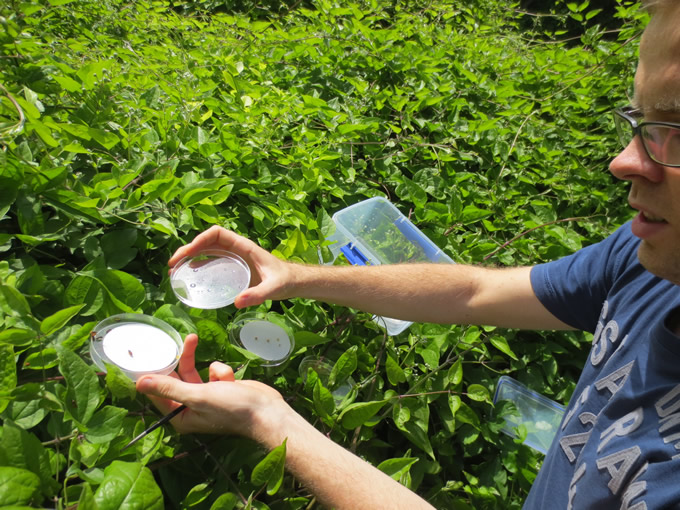Two Agents Ready to Trim Old Man’s Beard
Approval to releasea bud-galling mite (Aceria vitalbae) to attack old man’s beard (Clematis vitalba) was given by the Environmental Protection Authority (EPA) in October 2018. It is hoped that this mite can provide a valuable tool in the long-running battle to reduce the vigour and harmful impacts of this rampant vine. Horizons Regional Council, which administers one of the regions worst affected by this weed, submitted the release application on behalf of the National Biocontrol Collective. With permission to release now granted, the next hurdle will be to establish a thriving mite colony that can provide material for field releases.
“Establishing a mite colony in containment has so far proved to be a tricky business,” said Lindsay Smith, who is overseeing the project. The mites have either arrived from Europe in poor condition or there have been issues with insect pests like aphids and thrips out-competing the mites on potted plants. These pests are not a problem on old man’s beard (OMB) grown outside, but in the warm, protected environment inside containment they can quickly become problematic. Sometimes it becomes impossible to control them without also harming the mites, or the plant quality becomes too poor to sustain the mites. Lacewings and ladybirds offer some level of control once in containment, but the best strategy is to prevent unwanted pests from initially colonising plants through insecticide treatment. But this can also be problematic, at the very least requiring a substantial withholding period before the mites can be put on treated plants, by which time they are once again vulnerable to attack from other insects.
A fresh attempt to establish a mite population in containment will be made in June. All possible measures will be taken to prevent unwanted pests from colonising potted OMB plants. Also, to avoid any shipping issues, mite expert Dr Biljana Vidovic from the University of Belgrade, Serbia, who completed the host specificity testing of the mite, will hand-deliver them. She will also help with the painstaking transfer of the tiny (<1 mm long) mites onto potted OMB plants in containment. The plan is to rear the mites in containment until leaf burst occurs on OMB in early spring, and then begin field releases. “Galls caused by mites stunt new plant growth and offer the mites protection from unfavourable weather conditions and predation,” said Lindsay. It is uncertain how the mites will perform in NZ or how quickly they will reproduce. However, the OMB gall mite is closely related to the broom gall mite (Aceria genistae), which has performed exceptionally well since its release, so hopes are high that it will also do well.

Lindsay has also been involved in attempting to improve establishment of the OMB sawfly (Monophadnus spinolae). This agent was first released in the 1990s but is only present in low numbers at one of the 16 release sites. It seems likely that due to mass-rearing challenges the releases were sub-optimal: probably, with hindsight, they were too small, and possibly skewed towards males. Unmated females will only produce males, and even mated females will produce only male offspring if conditions are not optimal for them. So the plan this time is to put out a large number of sawflies, with a good sex ratio, at an ideal site (based on observed preferences in Serbia – sunny with sandy soil) to see if they do better. If we can establish a sawfly ‘nursery’ in this way it can later be used to supply other OMB-infested areas. A fresh sawfly shipment from Europe was imported into containment last May. This material had its identity and disease-free status confirmed and was then successfully reared through three generations. “We managed to crack the rearing procedure this time and produce good numbers of both male and female sawflies,” said Lindsay.
The sawflies were released in stages in December near the Waipara River in North Canterbury as material became available. “The sawflies seemed very happy to be out of containment, with mated females ovipositing the moment they settled onto a leaf!” said Lindsay excitedly. Already there is feeding damage starting to appear on plants, and three male flies were spotted flying around, probably from larvae released in early December. This augurs well for another generation this season. Adult sawflies, especially females, can be difficult to spot as they often sit on the underside of leaves. The larvae are the damaging life stage and are much easier to see, being white and creating obvious semi-circular feeding notches along leaf edges.
In southern central Europe the OMB sawfly has two generations per year. The first generation of larvae, produced in spring, drop to the ground and pupate for a few weeks, emerging as adults by midsummer. However, second-generation pupae remain in the soil in their cocoons from late summer through until the following spring. In the milder oceanic climate of New Zealand there may be sufficient time for the sawflies to complete a third generation. We will revisit the Waipara site next spring to search for signs that the attempt to set up a nursery site is succeeding.
This project is funded by the National Biocontrol of Weeds Collective.
Contact: Lindsay Smith (smithl@landcareresearch.co.nz)
